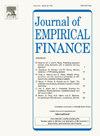Option-implied idiosyncratic skewness and expected returns: Mind the long run
IF 2.4
2区 经济学
Q2 BUSINESS, FINANCE
引用次数: 0
Abstract
This article examines the time-series predictive ability of the monthly option-implied idiosyncratic skewness () for the aggregate stock market. We find that is a strong predictor of the U.S. equity premium using both in-sample and out-of-sample tests at forecast horizons up to 36 months over the period from January 1996 to December 2021. In comparison, outperforms the previously used financial and macroeconomic variables. Furthermore, combining information in the transitional predictors with can further improve the forecasting performance than using alone. We provide two explanations for the documented predictability. First, exhibits strong procyclical behavior and consistently declines ahead of economic downturns. Second, acts as a forward-looking signal of investor sentiment and disagreement—positive shocks to significantly increase both future investor sentiment and disagreement, with effects that persist over several horizons.
期权隐含的特殊偏度和预期回报:注意长期
本文考察了月期权隐含的特殊偏度(Skew)对总股票市场的时间序列预测能力。我们发现,在1996年1月至2021年12月长达36个月的预测期内,使用样本内和样本外测试,Skew是美国股票溢价的有力预测指标。相比之下,Skew优于之前使用的金融和宏观经济变量。此外,将过渡预测器中的信息与Skew相结合可以比单独使用Skew进一步提高预测性能。我们为记录的可预测性提供了两种解释。首先,偏度表现出强烈的顺周期行为,并在经济衰退之前持续下降。其次,Skew是投资者情绪和分歧的前瞻性信号——对Skew的正面冲击会显著增加未来投资者情绪和分歧,其影响会持续几个时期。
本文章由计算机程序翻译,如有差异,请以英文原文为准。
求助全文
约1分钟内获得全文
求助全文
来源期刊

Journal of Empirical Finance
Multiple-
CiteScore
3.40
自引率
3.80%
发文量
59
期刊介绍:
The Journal of Empirical Finance is a financial economics journal whose aim is to publish high quality articles in empirical finance. Empirical finance is interpreted broadly to include any type of empirical work in financial economics, financial econometrics, and also theoretical work with clear empirical implications, even when there is no empirical analysis. The Journal welcomes articles in all fields of finance, such as asset pricing, corporate finance, financial econometrics, banking, international finance, microstructure, behavioural finance, etc. The Editorial Team is willing to take risks on innovative research, controversial papers, and unusual approaches. We are also particularly interested in work produced by young scholars. The composition of the editorial board reflects such goals.
 求助内容:
求助内容: 应助结果提醒方式:
应助结果提醒方式:


